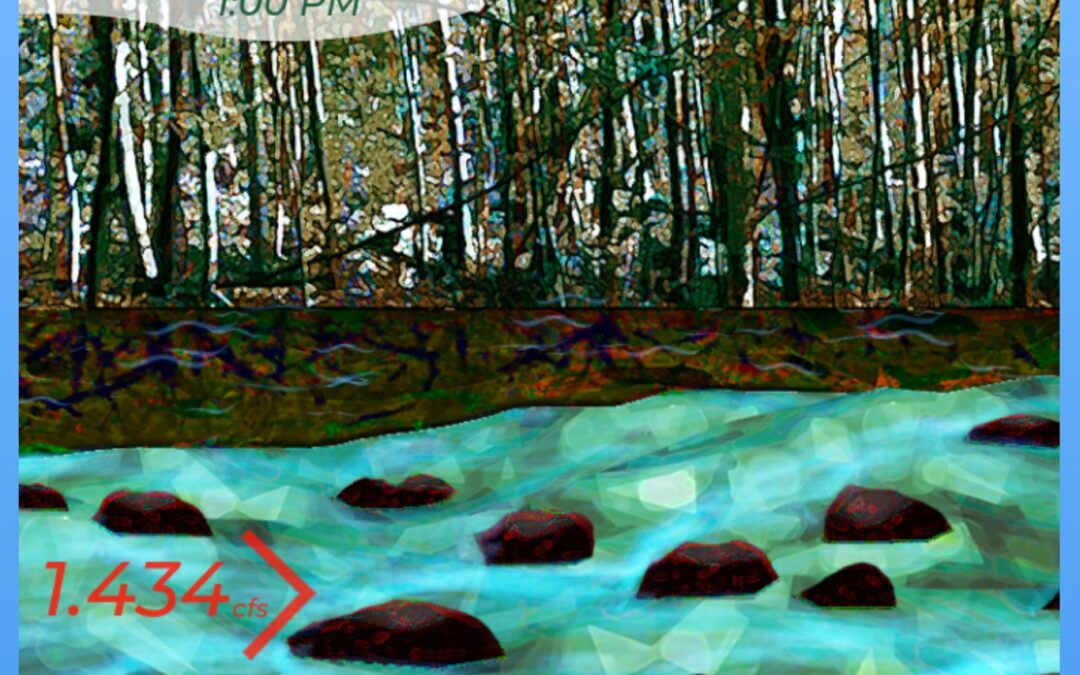Pardon me for sounding cynical but over the years I have become dubious about claims that art can bring science to the masses. It seems to me that translating the quantitative into the qualitative usually creates little insight for the general public.
But even if that is true – and I admit it could be geek-snobbery in action – maybe I’m missing something. Maybe I’m overlooking the insight it creates for the scientists.
“For me, as a scientist, the point is how can I better do my science by working with artists, recognizing that artists have a different lens and a different way of looking at things,” said Lindsey Rustad, a researcher and team leader at the USDA’s Northern Research Station in Durham who has spent decades studying at the Hubbard Brook Experimental Forest, where some of New Hampshire’s most intriguing science has been done.
To explain, she pointed to work by Marty Quinn, a composer and computer scientist who creates animated art among other things.
“He was looking at patterns in different data and he had coded wind direction data at Hubbard Brook,” she recalled. “He looked at it and colors went from dark blue to white to dark blue to white – just a really regular pattern. He came to me and said Lindsey, what’s this regular pattern? We looked at it a little bit closer and damned if it wasn’t mountain-valley breezes, called katabatic winds” flowing through the central valley of the 8,700-acre experimental forest.
Katabatic winds are pushed by rising and sinking air masses as each day’s sunset or sunrise, sweeping across the landscape, changes air temperature in one area before it does so in another. “It is like the tides, except it’s an air mass bathing the valley on a cyclical basis.”
Considering that Hubbard Brook Experimental Forest has been the target of studies by literally hundreds of scientists since it was established in 1955, you’d think this pattern would have been well understood but Rustad says the artwork was a revelation. By coincidence Eric Kelsey, a research professor at Plymouth State University, was observing the patterns at the same time with scientific data, “and has since developed a program about katabatic breezes,” Rustad said, showing how the artistic and the scientific approach can converge.
As a more general example, Rustad, a biogeochemist and ecologist, remembers walking in the woods with Xavier Cortada, a Florida artist.
I think I know how things work …. and I was trying to explain to him how water moves through the forest, using the standard textbook model. Xavier kept asking these annoying questions – ‘Lindsey, look at the dew on the leaf, where does that fit into your model?’ ‘Lindsey, here’s a little pool of water that doesn’t seem connected to anything – how does that quantify and fit into the model?’,” Rustad recalled.
“I was seeing the hydrologic world through my academic lens. I realized it was much more complicated than my reductionistic model.”
Perhaps it’s not surprising this happened at Hubbard Brook, which has long emphasized an art-and-science connection, sending artists out into the field with researchers and joining C.P. Snow’s two cultures in frequent conversation.
Some of the results are on display now at Plymouth State University’s Museum of the White Mountains. The exhibit, “Field Station: Art-Science in the White Mountains,” brings together works by many artists who have had residencies at Hubbard Brook. They range from traditional paintings to an interactive audio/visual examination of the many ways water flows through something as complicated as the northern forest.
The exhibit runs through Feb. 10; it’s free but advance online registration is required via www.plymouth.edu/mwm.
The 8,700-acre Hubbard Brook Experimental Forest on the southern edge of the White Mountains, stretching west from Thornton, is one of a series of long-term ecological research (LTER) sites around the country to study various ecosystems. It is most famous for being the site where acid rain was discovered but has hosted work resulting in literally thousands of published research papers, with titles from “Song rate variation in the black-throated blue warbler” to “Using C-13 nuclear magnetic resonance spectroscopy to study northern hardwood tissues” to the alarming-sounding “Why has Hubbard Brook Forest stopped growing?”
As the name implies, LTERs like Hubbard Brook are places to do ecosystem studies providing insight over years or decades or, with any luck, centuries. Maybe that explains the openness to art: an emphasis on unusual time scales might make people more open to unusual viewpoints.
As for me, I promise to be more open, too. The next time somebody turns the scientific world-view into poetry, music, dance or painting, I will embrace the work and try to learn from it.
Unless it’s mime – then, forget it. I have to draw the line somewhere.


 Return to the Concord Monitor
Return to the Concord Monitor
You might enjoy “Proust was a Neuroscientist” by Jason Lehrer. It addresses the confluence of art and science. Both require imagination and creativity.